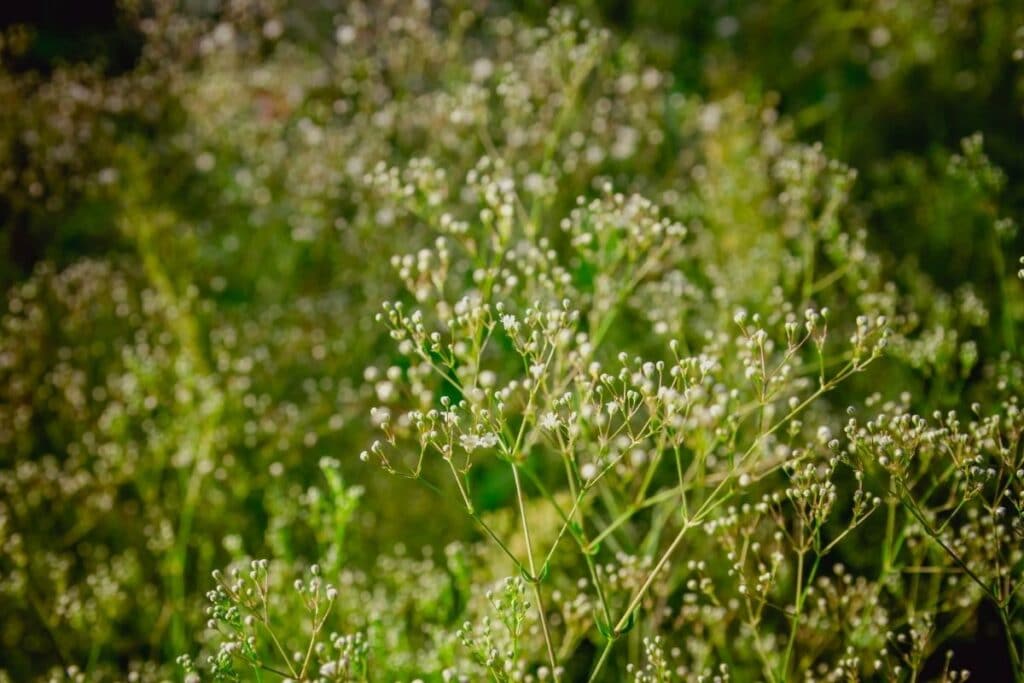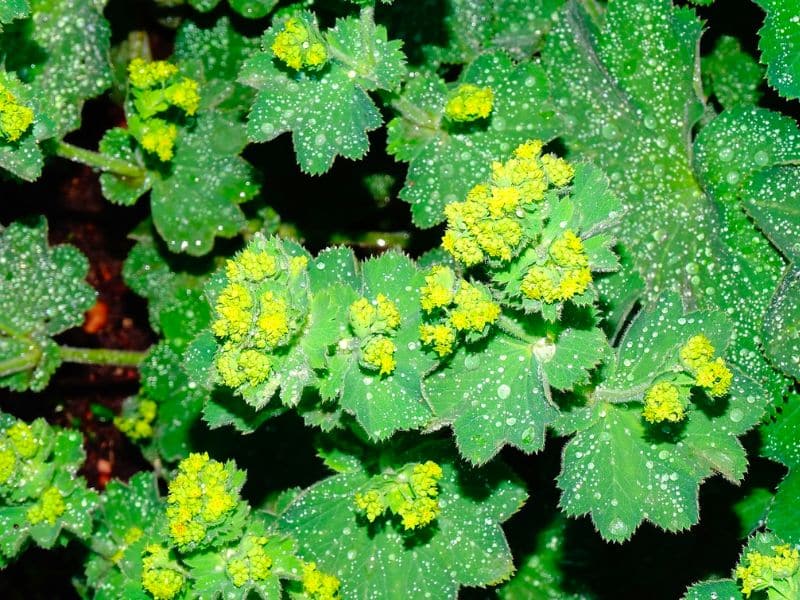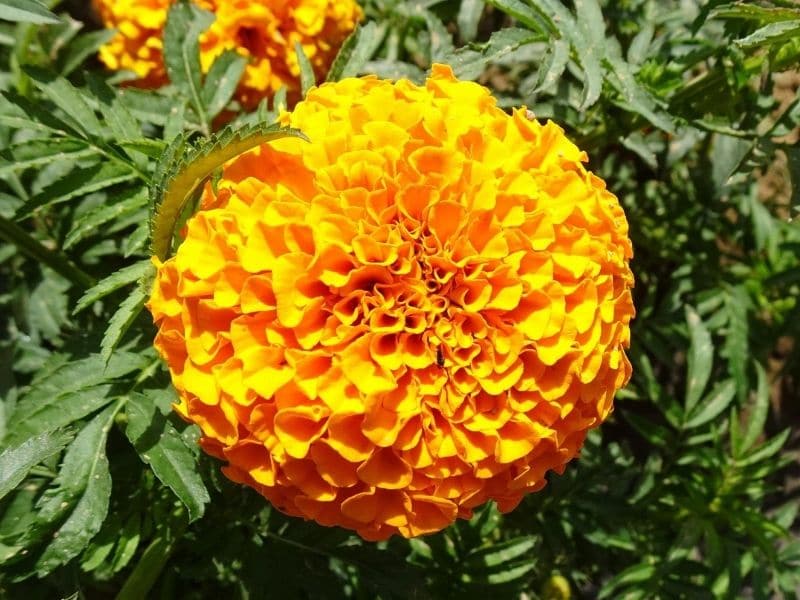Find rose companion plants that will protect or enhance the look of your roses in this guide where we share a list of the best plants for rose gardens.
Roses (Rosaceae) are probably the most renowned flowers in the world. These flowers with their gorgeous blooms are grown across the globe for agricultural and ornamental purposes. There are thousands of rose cultivars and they can be found in shrub, climbing, or trailing form.
Companion planting with roses can be extremely helpful for promoting the health of these plants or for enhancing the aesthetic appeal of these gorgeous floral bushes.
In this guide, we are going to take a look at some of the best plant varieties to grow with roses to deter aphids and keep pests away and the bad ones to avoid.
What to Plant with Roses
Rose gardeners need to be careful to select neighboring plants that have the same growing conditions as roses. Pairing your roses with plants that don’t have the same growing needs can mean a lot more maintenance or could impact your rose garden negatively.

These woody perennials need to be grown in direct sun (6 – 8 hours of direct sun per day) in well-drained soil that contains lots of nutrients. The right companion plants will also look good alongside your rose bushes and it is best to choose a neighboring plant that offers additional benefits like the ability to repel pests.
Let’s take a look at some of the best companion plants for roses.
Ornamental Plants to Grow With Roses
In residential gardens, roses are mostly grown for decorative purposes. In these cases, you will likely be searching for a plant that is going to look great in your rose garden. Let’s take a look at some ornamental plants that have similar growing requirements as roses.
Baby’s Breath

Baby’s breath (Gypsophila) is at the top of our list because this bushy plant with its delicate white or light pink flowers is commonly used in rose flower bouquets. These are wonderful rose companions whether you are trying to create a gorgeous soft white front drop for a large rose bush or need a beautiful backdrop for dwarf rose varieties.
This perennial shrub is very easy to grow and maintain. You can grow Baby’s Breath in the same garden bed as your roses because it grows well in loose, dry soil and dry climates.
The brushes can reach a maximum height of up to 1 meter and will only flower if it receives plenty of direct sunlight. You should keep this in mind when pairing the foliage with roses so the thick brush won’t obscure your view of the rose blossoms.
Remember to leave plenty of room between roses and other foliage so these shrubs can easily develop and spread.
With these two companion plants, you can create gorgeous flower arrangements when you are harvesting flowers for indoor use.
Lavender

It’s very common to see lavender and roses companion planting in many gardens.
Lavender (Lavandula) is often spotted in rose gardens because the beautiful purple flowers with their spiky design create a powerful contrast against the soft and delicate cupped roses. The pale green of lavender leaves will also add visual interest while the fragrance of lavender is sure to make your garden smell terrific.
Lavender will flourish in a rose garden bed because it grows well in dry climates and it needs lots of direct sunlight to bloom. This drought-tolerant plant also loves soil that drains very well and won’t deprive rose bushes of nutrients.
Some people also believe that growing lavender can protect your rose bushes because it will act as a sacrificial plant and will lure pests like aphids away from your roses. It’s one of the popular front yard companion plants for roses.
The best way to pair these two plants is by establishing your row of lavender a couple of feet in front of rose bushes. This is because roses do need a little bit more water than lavender and you don’t have to fertilize lavender when you are adding nutrients to your roses.
Both of these companion plants can be harvested for indoor flower arrangements since they have a similar flowering seasons. Roses and lavender are also often dried for preservation or to use as a fragrance enhancer.
Related: Companion planting for lavender
Mexican Feather Grass
If you want to add more texture to your garden then we recommend Mexican feather grass (Nassella tenuissima). These ornamental grasses are often spotted in flower gardens because they serve as a terrific backdrop or filler material that can make your flowers stand out even more.
This grass variety usually grows about 60cm in height with lime-green foliage and it produces feathery white tips (flowers or seeds) that give a soft and whimsical appearance. This plant species grows well in full sunlight but it can be grown alongside roses since it can survive in partial shade.
When you are growing roses and decorative grasses together, it is usually best to use these spiky plants as a border in front of taller roses. You can also grow Mexican feather grass alongside shrub roses if you want to fill out gaps or conceal certain areas around your bushes.
Avoid pairing feather grass with short or dwarf rose varieties since the dense foliage of the grassy plant can obscure sunlight or hide away some of those beautiful rose blooms you might want to show off.
Lady’s Mantle

Lady’s mantle (Alchemilla Vulgaris) is a good rose companion plant to consider if you are looking for smaller plants to pair with miniature roses. This herbaceous perennial usually only grow up to 30 centimeters (12 inches) tall and is very useful as a ground cover to keep weeds from sprouting amongst your roses. Many gardeners also use it as a border plant to create more contrast between a lawn and a rose bed.
When this plant blooms in late spring to early summer, it will create vivid yellow flowers but even the vibrant lime green foliage is sure to look fantastic in front of roses.
You can grow Lady’s mantle directly underneath rose shrubs because they grow well in dappled shade. If you grow them too far away from your roses, they can become scorched by the intense sunlight. These plants don’t need a lot of soil nutrients and they can grow well in any type of well-draining soil.
Read more: Lady’s Mantle Companion Plants
Companion Plants to Boost The Development of Roses
Some plant varieties can do a great job of protecting rose bushes from pesky insects that might feed on your beautiful flowers. Certain companion plants help repel pests while others attract beneficial insects that feed on rose pests. Here is a quick look at the best companion plant species to include if you want to protect your rose garden.
Alliums

Ornamental onions (Alliums) are excellent companion plants to include in just about any garden because the strong odor of these plants is helpful for warding off all sorts of pests like aphids, slugs, snails, and rabbits and will give your roses texture.
For rose gardens, we recommend ornamental alliums that produce beautiful flowers such as the giant allium (A. Giganteum). Other varieties like garlic or scallions can also be a good option if you want to add some texture to your garden or if you want to protect your roses during the flowering season.
Giant alliums, with their long stems, will create lots of interest in your garden because they produce large flowering heads that consist of multiple tiny purple flowers. These purple orbs will appear from late spring to early summer and will look fantastic if paired with a complimentary rose color variety like white or pink roses. You can also pair these purple flowers with red or orange roses to create more contrast in your garden.
Persian onions will flourish in well-draining soil with plenty of sunshine. If you want to display those tall spires amongst your rose blooms then you can grow these members of the onion family amongst rose shrubs because they will also develop well in partial shade.
As with roses, these flowers can also be harvested and kept indoors in vases or be used for flower bouquets.
Marigolds

Most species of marigold flowers (Tagetes) are ideal companions for roses because they can protect your rose garden from all sorts of nasty pests. For a rose garden, we recommend French marigolds since this specific variety is exceptionally good at deterring pests like harmful nematodes that can affect the root system of your rose garden.
Marigolds will attract pollinators like bees and butterflies to your garden while the scent of these flowers will also attract beneficial insects. You can use marigolds as a trap crop to lure pests like common rose-loving Japanese beetles or rose beetles away from your roses.
These rose companion plants can also enhance the look of rose gardens if you grow them with complimentary rose colors like red, orange, white, or yellow. Pairing these two plants is sure to create a huge explosion of color in your garden.
It is usually best to grow marigolds in a row in front of roses. This way, these drought-tolerant plants will lure those pests well away from your roses and you will still be able to enjoy the scenic view that these plant pairs can create.
Related: Should you plant marigolds in a vegetable garden?
Parsley
Since parsley (Petroselinum crispum) is a herb, most people don’t think of using it in rose beds. These aromatic plants do however offer roses many benefits.
A row of vivid green parsley will look charming against a backdrop of beautiful roses and these plants have natural substances in their leaves that discourage pests. Parsley can protect your rose bed from pests like aphids and rose beetles and many also believe that this herb enhances the fragrance of rose blossoms. These low-profile plants will also act as a ground cover and will keep other plants or weeds from sprouting in your garden bed.
This is a good companion plant that will grow well alongside roses because it can successfully grow in well-draining soil in most climates. Since parsley can also grow in dappled sun, it won’t be bothered too much if you grow it underneath a rose brush.
Most rose gardeners like to grow parsley as a barrier around roses because this herb does sometimes require a little bit more water than roses, especially in extreme heat conditions.
Sage
Russian sage (Perovskia atriplicifolia) is another favorite in rose gardens. Some of the best qualities of this plant are its ability to repel aphids and beetles but many gardeners grow this plant for ornamental purposes.
Culinary sage produces purple or blue flowers on tall spikes and attracts pollinators like hummingbirds and bees to your garden. Those beautiful blooms won’t appear until mid-spring but will continue until fall. The purple flowers will look great in front of rose colors like deep reds, whites, yellows, or pinks.
This herb grows well in hot and sunny regions. It is best to use sage as a border plant around your roses so they can get plenty of sunlight and so the purple flowers can stand out in front of the green foliage of the roses.
See more: What to plant with Russian sage
What NOT to Plant With Roses
Gardeners should also be aware of other plants that need wet soil. Rose bushes require well-drained, slightly dry soil and cannot tolerate having their “feet” in wet soil for long periods of time without developing problems.
To ensure healthy, vibrant roses, at least six hours of direct sunlight is suggested each day. Because of this, you should take into account the height and growth habits of each companion plant.
You will usually want more petite plants to pair with roses, but there may be instances where your climbing roses require larger partners for hiding unsightly lower stems. Avoid any invasive plants that can quickly take over your rose bed and become a nuisance.
As rose bushes thrive in a slightly acidic soil with an ideal pH range of 5.5 to 6.5, any plants grown alongside them should also require the same acidity level and not need amendments that would increase the alkalinity of the soil instead.
FAQs
What is the best companion plant for roses?
The best companion plants for roses include those that attract beneficial insects, repel pests, or provide contrast in color and texture. Some popular choices include lavender, geraniums, marigolds, catmint, and salvia.
What is the best ground cover around roses?
The best ground cover around roses depends on various factors such as climate, soil type, and personal preference. Some suitable options include creeping thyme, creeping phlox, sedum, and groundcover roses.
Can you plant lavender next to roses?
Lavender can be planted next to roses as they complement each other well in terms of fragrance and appearance. Lavender’s aromatic foliage and flowers can also help repel pests that may affect roses.
What plant mix for roses?
A good plant mix for roses includes companion plants that attract pollinators, repel pests, or improve soil health. Consider planting a variety of flowers such as marigolds, geraniums, salvia, and catmint, along with herbs like lavender, rosemary, and thyme.
Final Thoughts
We hope that our guide made it easy for you to find compatible plants for your rose garden bed and that these companions will help you achieve the best rose blooms yet. If you want to learn more about companion planting with other types of plant species then you should have a look at some of our other guides. With our guides, you can create a fabulous-looking garden or promote the health and development of any plant species.
See more:







